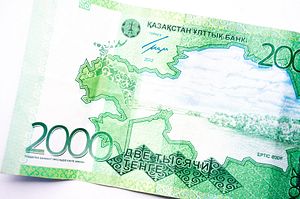On May 2, Kazakhstan’s Stock Exchange published a statement by Tengri Bank, AsiaCredit Bank, and Capital Bank, according to which the three banks will decide at a joint shareholders’s meeting on May 31 on the terms of a merger, possibly creating a new financial pole in the country. At the end of last month, Tsesnabank, one of the country’s largest banks, changed its name into First Heartland Jusan Bank, while major shareholders of the largest lender could sell part of their stakes, in another shake-up of the country’s banking sector.
Tengri Bank used to be PNB Kazakhstan, a subsidiary of India’s Punjab National Bank, which owned 84.38 percent of the bank until mid-2015 when it divested prompting the name change. The Indian lender now owns 41.64 percent of Tengri.
A merger between Tengri and Capital was already laid out in early 2017, but the plan fell through. Then, analysts highlighted the history of Tengri as a pocket bank for the infamous Kuanyshev family, on the radar of both to UK tabloids and financial crime press. Alfiya, the wife of businessman Timur Kuanyshev, still owns 9 percent of Tengri Bank, while Doulat, Kuanyshev’s brother, serves as ambassador to Israel after a stint in New Delhi.
AsiaCredit and Capital have served the interests of two of Kazakhstan’s richest businessmen: Nurbol Sultan and Orifdzhan Shadiev, ranked 42 and 31 respectively among Forbes’ 2018 list of the richest businessmen in Kazakhstan. Importantly, both AsiaCredit and Capital are smaller, troubled financial institutions. The rate of overdue loans earmarked as toxic assets and responsible for the endless banking crisis in Kazakhstan, grew above 50 percent in recent months, while corporate clients have left en masse. Tengri’s track record, especially with foreign capitals, had been more successful.
A merger would create a small-to-mid-range actor that would position itself among the seven banks that own control of between 1 and 2 percent of the market.
A much bigger actor, meanwhile, is climbing down the charts. Tsesnabank lost ground in the ranking of Kazakhstan’s banks, changed shareholders, name, and policy. It is now known as First Heartland Jusan Bank (FHJB), merging the name of First Heartland, its main shareholder, and the Kazakh word for “wormwood.” First Heartland is also the name of another bank of the same group of investors. That bank was first established as a foreign branch of Britain’s Royal Bank of Scotland, the first bank with foreign capital to enter the Kazakh market.
FHJB fell from second to ninth place among Kazakhstan’s banks in just a few months. The Dzhaksybekov family relinquished control of the bank in September last year. In mid-May, First Heartland Bank and FHJB are poised to merge, ending any ambiguity between their names and owners.
Meanwhile, Halyk Bank, Kazakhstan’s largest bank which controls 35 percent of the market, could diversify its ownership after its majority shareholder, ALMEX Holding, announced it could sell shares for cash to improve the bank’s financial position. ALMEX owners, Timur Kulibayev and his wife Dinara, ex-President Nursultan Nazarbayev’s daughter, are the richest family in Kazakhstan.
Naturally, any movement from a giant such as Halyk overshadows major changes among the smaller players. Yet, it is important to track the changes in Central Asia’s most active financial sector. The rise and fall of certain banks could also mirror the fate of the elites that own or control them.

































